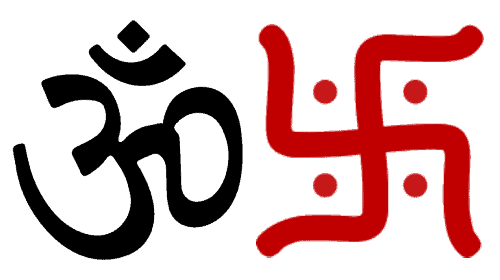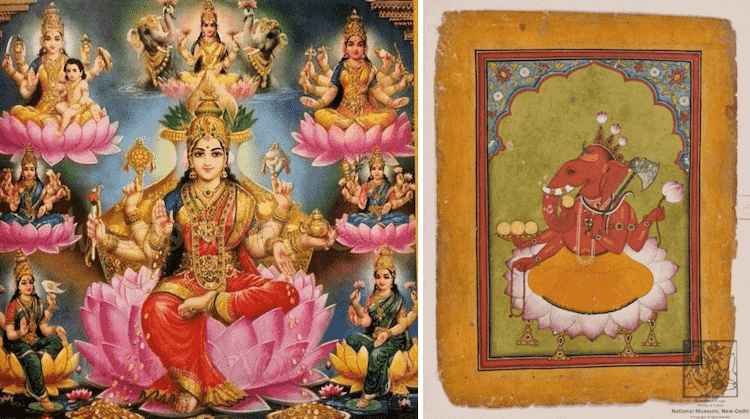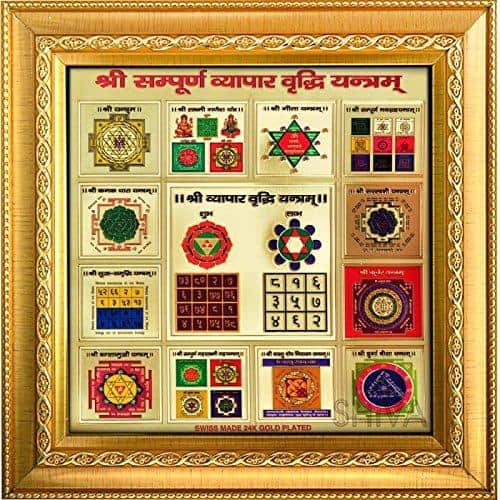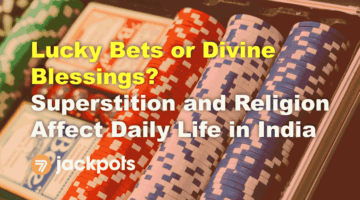History and Religion Still Define Us Today
India’s past is full of legends and religious beliefs; some have also helped carry over practical traditions. Even when their origin is vague, most have a reason to exist to this day and age.
The modern representation of auspicious symbols in desi culture results from this historical process mostly consolidated around religious doctrines. Religion is more publicly visible in India than in most Western cultures, with sacred spaces, architecture, and even holy rivers.
Jawaharlal Nehru’s ideal of “unity in diversity” lies, among other things, in being able to identify with one’s compatriots through common traditions and beliefs – those tend to blur state, ethnic, and caste boundaries. Some symbols have actual religious backgrounds; others are simply habits or irrational beliefs. With time, these have all proven to be strong bonding elements for the entire Subcontinent.
While Hinduism is the biggest faith system in the land, Buddhism, Islam, Sikhism, Jainism, and Christianity have their space and cultural contribution. This makes up for a massive register of icons, philosophies, and superstitions that paradoxically create the pragmatic links between Hindus and others.
In the end, the body of traditions and symbolic manifestations connect India’s past and present, religion and secular life, legitimising even casual superstition as an important part of people’s daily routine.
Lakshmi and Ganesha Bestow Divine Patronage
The pursuit of fortune and well-being is an essential part of one’s life path. Indians consistently seek divine intervention, honouring the Gods for their benevolence in granting them wealth, luck, or spiritual abundance.
Lakshmi is one of the most important deities linked to the essential human pursuits (Dharma, Artha, Kama and Moksha). Artha notably includes pursuing a career, wealth, financial prosperity, and security. Hence, Lakshmi is especially revered by those seeking abundance and a better turn of events.
Also known as Shri or Mother Goddess (but with over 70 aliases in total!), she is Vishnu’s wife and divine energy. With influence over our positive attitude, she inspires immaterial well-being and qualities like strength, courage, determination, and hope. Together with Parvati and Saraswati, Lakshmi forms the Triad of great goddesses (Tridevi).
Divine Patronage
Worshipped for her unlimited blessings with luck and power, she is found everywhere in India, surrounded by symbols like a red lotus, a shower of gold, or elephants (Gajalakshmi). The mystical lotus stands for purity and prosperity despite difficulties.
Lakshmi’s eight manifestations (Ashta Lakshmi) are known as the Eight sources of wealth. Adi Lakshmi’s mudras (finger gestures) stand for fearlessness and blessings, while Dhana (“Wealth”) Lakshmi bestows us gold, property, and other tangible riches.
Spiritual abundance entails strength, courage, determination, and perseverance. Vijaya (meaning “Victory”) Lakshmi grants worshippers success, hope, and inspiration.
Ganesha is also worshipped across the nation for his influence on luck. Instantly recognised by his elephant head and big belly, the son of Shiva and Parvati, he is the master of ceremonies invoked at pujas (prayers) and weddings, granting us wisdom, success, and fortune. A “remover of obstacles,” Ganesha is also worshipped by Buddhists and Jains.
The Eight manifestations of Lakshmi: luck, health, prosperity, progeny, fertility, strength, knowledge, and power. Ashta Lakshmi and Ganesha are seen everywhere around India.
Lucky Bets or Divine Blessings – Lucky Symbols Abound
Indian traditions are seen in a variety of icons and amulets. Many of these attributes come with the inevitable religious background, as they help the Gods pass their teachings and spiritual messages to mortals.
The Ashta Mangala is a prime example, with eight fortunate signs in an iconic set – shell, knot, fish, lotus, parasol, vase, chakra, and victory banner. Closely related to Hinduism (but also Buddhism and Jainism), the Ashta Mangala is heavy on tantric significance, which has carried over into decorations of modern secular lifestyles.
This has also been the case of Aum (Om) – the essence of mind, spirit, and body in Hinduism. Being a self-standing auspicious symbol, it has already become a lucky charm for many, a mere amulet. Many outside India, even non-believers, wear it as a pendant or a good-luck talisman. Urban desi youth regularly flaunt it as a fashion statement.
The Swastika also signifies prosperity and a fortunate design across Asia. The right-facing one is “conducive to well-being” and a symbol of good luck as well as the sun. The left-facing version (called Sauwastica) actually stands for the night and Kali, the demon-Goddess of time, darkness, and death.
Although the Swastika suffered from its nazi adoption a century ago, it remains a lucky symbol in present-day Asia and India in particular. One can see it on temples, businesses and various buildings, including the Ahmedabad Stock Exchange and the Nepal Chamber of Commerce. The words Swastik and Swastika (with spelling variations) are male and female first names, respectively. The Government of Bihar also employs two swastikas on its state logo.

Are Gamblers More Superstitious?
In the context of casino gambling, sports betting, and lottery games, these rituals, and symbols may not have an instantly apparent influence. Offshore platforms, in particular, rarely pay attention to visual influences of that kind. However, the average desi player is certain to hold at least some of the above dear to their chances of gaming success.
Holidays are prime examples of the employment of such rituals and symbols. As the Festival of Lights, Diwali is among the most important social occasions. The height of Lakshmi celebrations coincides with the lasting tradition of gambling with family members and friends.
Indians believe that dice games are auspicious during Deepavali because Parvati played with her husband, Shiva. Gratified by the experience, she blessed all who followed suit with prosperity throughout the year. Over time, the dice set was replaced by card games with loved ones – particularly Teen Patti, although some prefer rummy or poker during holidays.
The tradition of family gambling holds out through Gaja Lakshmi Puja, the colourful peak of the harvest festival. Since it is particularly important to stay awake through Full Moon, people find it stimulating to challenge their luck and play real-money card games to make it through the night.
Looking for Luck Beyond Religion
Of course, regular desi gamers have their favourite talismans, lucky charms, crystals, or jewellery with them, whether in the casino in Goa or when playing online from the couch at home. Some observe totally unrelated superstitions which influence luck or the lack of it.
Most Indians agree that an itching palm affects their finances. For women, an itching left palm means money is coming their way, while an itching right palm says they are likely to lose money. It is the exact opposite for men.
Some beliefs are more detailed and eventually codified. For example, Vastu Shastra (or Vaastu Sastra) is widely used in India for interior and exterior design, more so than Feng Shui. Spatial arrangements influence the layouts of homes, gardens, towns, shops, and businesses.
The “science of architecture” is dispersed in various texts on traditional Indian design. Vastu principles invite growth, peace, and happiness in such spaces. Surveys confirm that this arrangement philosophy is just as popular as lucky charms in workplaces and households.
Indians also often carry black chirmi beads or rudraksha necklaces, even if they are not firm believers in religious doctrines. Black chirmi are said to find their proper owners as their miraculous powers do not let them settle with an unlucky person. Rudraksha seeds are originally intended as Hindu prayer beads, but their popularity transcends such contexts.
These good luck charms can be found in pockets or purses and combine mythology and personal notions of fortune and prosperity. They are “known” to repel evil-eye and negative energy, as well as any money problems.
Astrology and Numerology Still Inspire
Considering India’s relatively high literacy rate, it may be surprising how much faith its population has in bizarre traditions and pure superstitions.
Yantras are another great example of symbolism with inexplicable origins. Yet, these occult diagrams are used to ask for the gods’ help or simply reach out to benevolent spirits. Their supernatural powers are based on astrology and are thought to bring luck, health, and financial prosperity.
Hindus also have their favourite numbers, generally preferring odds over evens. Seven and Eight are considered especially auspicious, meaning success and prosperity. Number sequences like 786 and 108 also stand out as lucky and even sacred.
108 is particularly important – considered a link to Dharma, the honorific of gurus, the number of completeness, a multiple of 9, and the proper number of beads on a prayer string.
786 stands for the Trimurti (Trinity) of Brahma, Vishnu, and Shiva. Recently, media outlets reported people exchanging currency notes with serial numbers containing 786 for outrageous sums (tens of thousands of US dollars).
And then there are the lucky gemstones and jewels, carefully selected with the help of personal horoscopes. Reputable astrologers study them and develop a shortlist of compatible and auspicious gems that can produce the desired effects on people’s lives, especially their financial standing.
Lucky Fruits and Plants
Fresh fruit is often seen as an altar gift for the gods and a vehicle of positive energy. Peaches symbolise immortality, money, and abundance, while Pomegranates help with fertility issues. While the North draws positive energy from apples, the South seeks prosperity and abundance from pineapples and oranges. And whenever fresh fruit is unavailable, people put up paintings or decorations of those.
In such contexts, money-attracting plants cannot be a surprise. Many simply bring “positive vibes” into a household or an office, like the Holy Basil, which most Indians have in their home. Others are thought to impact material abundances, such as the twisted Money Tree or the evergreen Chinese Money plant.
Some are positioned in particular spots (according to Vaastu or Feng Shui) – the Baby Jade plant should be near the entrance of businesses to usher in wealth and prosperity. Others are simply too common and undemanding, like the Lucky bamboo, which is known to bring fortune and abundance worldwide.
Lucky Bets or Divine Blessings – Superstition Is Undeniable
The pursuit of luck leads people to try out various sources for supernatural help. Some objects (and behaviours) are considered fortunate and blessed; others are avoided for no apparent reason.
Indian superstitions share some of these ideas with other cultures, even Western ones – horseshoes are lucky, while black cats and broken mirrors can put a jinx on you. Desi society, however, has some quite peculiar beliefs of its own.
For centuries, Indians have had the habit of eating a spoon of curd and sugar before stepping out for an important task. While a rational explanation can be sought in the quick release of essential nutrients, people really do not think about why they do it.
Most families avoid sweeping after dark so as not to chase luck away. When a pigeon or a crow poops on someone, they often buy a lottery ticket since luck is sure to come their way on that day. And when an eye twitches, money is probably coming our way, or we are about to meet love. Again, the left eye is auspicious for females, and the right one is for males.
Complexity of beliefs
Business owners hang green chili and lemons outside so Alakshmi (goddess of misfortune) can stay out. Indians who want to avoid bad luck never do the following – shave on Tuesdays, wash their hair on Thursdays, cut it on Saturdays or trim their nails on Tuesdays and Saturdays.
We are advised not to shake our legs too strongly, even when bored, for we might kick away our wealth or accumulated knowledge. Sleeping under or even going near a Peepal tree (the sacred fig) is also unwise, as it is said to attract ghosts that might kill those found close to it after dark.
The complexity of beliefs sees Indians often reach out to a baba, guru, shastri, swami, bhagat, bapu, or simply, godmen. They teach, interpret and assist those who might need a hand in the labyrinth of symbols, rituals, traditions, and superstitions. Naturally, these services usually require some payment and have turned into a profitable profession for the well-versed.
Everyone Has a Lucky Symbol
Women are reportedly slightly more likely to indulge in superstition (80% compared to 68% of men). Surveys reveal, however, that most companies have their offices full of good luck charms. Bangalore and New Delhi top the lists as they rightfully represent the nation’s melting pots of ethnic groups, beliefs, and customs.
Even the infamous castes that often shape labor and social life cannot divide people in their worship of Lakshmi. All participate in the same festivals, albeit honouring a different aspect of luck and well-being.
Devotion and superstition have withstood social evolution, digitisation, and economic development. They are not in conflict with modern education or lifestyle. And are just as popular across Bharat as they are found among desi communities abroad. Corporate culture is not spared by superstition. And well-trained staff considers both traditional and supernatural beliefs essential to success and fortune.

What Does the Future Hold for Devotion and Superstition?
India’s rich heritage has seen a maze of religious and superstitious beliefs become acceptable and broadly compatible. Divine protection and supernatural help is actively sought – palm reading, astrology, numerology, and various prophecies are widespread and readily available.
Globalisation has boosted the demand for quick fixes and easy solutions. Smartphones and social media easily turn superstitions and spiritual notions into viral events. In the end, many still rely on traditional religion or “proven” personal talismans in their daily routine.
Indians take pride in accommodating so many beliefs and customs, festivals, and cultural features. A healthy desire to control one’s life path makes one pursue a complex mix of mystic symbols and fortunate beliefs with astounding ease.
It is not usually a game or a competition. Instead, it is all about the conviction that luck and abundance should be properly pursued. This attitude is likely to evolve further but not change in its foundations. Desi customs, beliefs, and daily habits will continue to be guided by the quest for divine support and fortunate mysticism.












